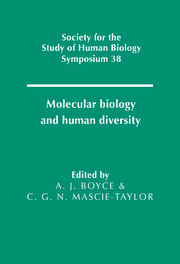Book contents
- Frontmatter
- Contents
- List of contributors
- Preface
- 1 Mitochondrial DNA in ancient and modern humans
- 2 Digital DNA typing of human paternal lineages
- 3 Minisatellites as tools for population genetic analysis
- 4 DNA fingerprinting: development of a technology and its application to the study of human populations
- 5 Kinship, inbreeding, and matching probabilities
- 6 Using the coalescent to interpret gene trees
- 7 Some attempts at measuring natural selection by malaria
- 8 AIDA: Geographical patterns of DNA diversity investigated by autocorrelation statistics
- 9 Mitochondrial DNA sequences in Europe: an insight into population history
- 10 Palaeolithic and neolithic contributions to the European mitochondrial gene pool
- 11 The molecular diversity of the Niokholo Mandenkalu from Eastern Senegal: an insight into West Africa genetic history
- 12 The peopling of Madagascar
- 13 Molecular perspectives on the colonisation of the Pacific
- 14 Population ancestry on Tristan da Cunha–the evidence of the individual
- 15 Linguistic divergence and genetic evolution: a molecular perspective from the New World
- 16 Allelic sequence diversity at the human β-globin locus
- 17 A nuclear perspective on human evolution
- 18 Contrasting gene trees and population trees of the evolution of modern humans
- 19 Methods and models for understanding human diversity
- Index
3 - Minisatellites as tools for population genetic analysis
Published online by Cambridge University Press: 19 September 2009
- Frontmatter
- Contents
- List of contributors
- Preface
- 1 Mitochondrial DNA in ancient and modern humans
- 2 Digital DNA typing of human paternal lineages
- 3 Minisatellites as tools for population genetic analysis
- 4 DNA fingerprinting: development of a technology and its application to the study of human populations
- 5 Kinship, inbreeding, and matching probabilities
- 6 Using the coalescent to interpret gene trees
- 7 Some attempts at measuring natural selection by malaria
- 8 AIDA: Geographical patterns of DNA diversity investigated by autocorrelation statistics
- 9 Mitochondrial DNA sequences in Europe: an insight into population history
- 10 Palaeolithic and neolithic contributions to the European mitochondrial gene pool
- 11 The molecular diversity of the Niokholo Mandenkalu from Eastern Senegal: an insight into West Africa genetic history
- 12 The peopling of Madagascar
- 13 Molecular perspectives on the colonisation of the Pacific
- 14 Population ancestry on Tristan da Cunha–the evidence of the individual
- 15 Linguistic divergence and genetic evolution: a molecular perspective from the New World
- 16 Allelic sequence diversity at the human β-globin locus
- 17 A nuclear perspective on human evolution
- 18 Contrasting gene trees and population trees of the evolution of modern humans
- 19 Methods and models for understanding human diversity
- Index
Summary
Many multi-allelic loci in the human genome are almost always due to variation in the number of repeats of a short DNA sequence and a number of investigators have demonstrated that the frequency distribution of such loci differs between human ethnic groups, making them a potentially valuable tool in the analysis of population relationships (Balazs et al., 1989; Bowcock et al., 1994; Deka, Chakraborty & Ferrell, 1991; Flint et al., 1989). However, a number of issues have still to be addressed before the full benefit of multi-allelic loci analysis can be felt. These can be divided into questions about the most appropriate ways to analyse allele frequencies, and technical questions about data collection. This chapter is devoted to the latter.
We discuss here one class of multi-allelic locus, the minisatellite or variable number tandem repeat (VNTR) which usually has unit sizes between 10 to 50 bp with alleles varying in size from 500 bp to 30 kb. The issues surrounding the collection of population allele frequencies at minisatellite loci can be divided into two: there are purely technical issues concerning the most effective way of extracting and recording data for analysis, and there are questions about how allele frequencies at one locus compare with those at another, and indeed with other types of DNA, protein and antigen polymorphism.
- Type
- Chapter
- Information
- Molecular Biology and Human Diversity , pp. 24 - 28Publisher: Cambridge University PressPrint publication year: 1996
- 2
- Cited by

